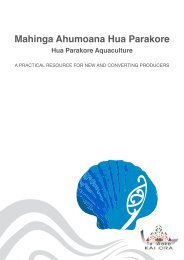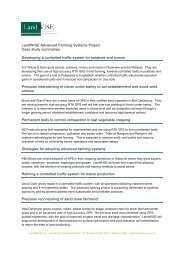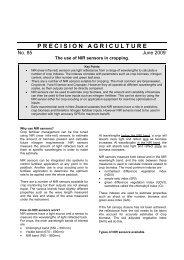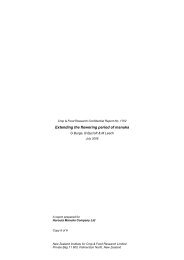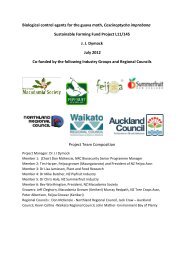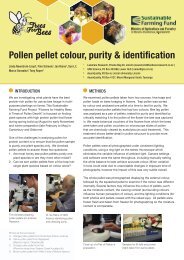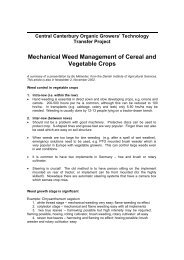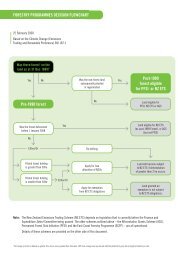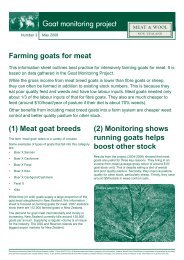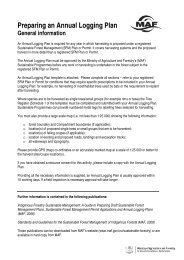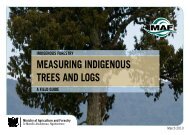Final report
Final report
Final report
Create successful ePaper yourself
Turn your PDF publications into a flip-book with our unique Google optimized e-Paper software.
Project objectivesThis project will deliver necessary information to develop cost effective programmes toreduce drench use, slow the development of resistance, and increase our understanding of thisimportant animal health issue in the large herd farms typical of the growing direction of theNZ dairy industry.1. Demonstrate the TST strategy which markedly reduced drench usage, withoutcompromising calf growth is repeatable over years and on variety of dairy farms.2. Simplify the mechanism of setting targets so the TST is easily adjustable for use on alldairy farms.ApproachThis study was carried out using four commercial dairy herds, which containing a mixture ofFriesian and Friesian x Jersey female calves, in Canterbury. On each of these farm 100 3-4month-old were allocated hierarchically by date of birth and liveweight to one of twotreatments groups (n=50) that were balanced for breed and allocated to one of two treatmentregimes. One regime (NST) consist of a neo-suppressive anthelmintic treatment regime inwhich all animals will be initially treated at monthly intervals with triple Combination Cattledrench until eight months-of-age (April -May). The remaining group (TST) will be allocatedto a targeted selective treatment regime in which the same anthelmintic used for NST animalswill be administered on an individual basis according to their ability to reach pre-determinedgrowth. All calves were weighed monthly and faecal samples were taken from calves at eachtreatment interval.On two farms a random sub sample of twenty animals was collected for FEC determinationfrom both NST and TST groups and on the other two farms all animals were individual faecalsampled at every sampling, from these samples bulk larval cultures were raised and larvalidentification were conducted.Calves on the four farms all had electronic tags which allowed farmers to utilise automatic tagreading and weigh of calves, however this option was only utilised on one of the properties.On two of the farms calves were removed to grazing properties at approximately 14 weeks ofage, on the remaining two properties calves were allowed to graze on the milking platform infront of the cows. All animals were treated with anthelmintic at approximately 8 months ofage (in late March/April) as a precaution on animal welfare groundsIndividual targets were set for each animal using the following formula for animals under130 kg:Target weight (kg) = (0.0086 x last LWT -0.318) x number of daysIf the animals are greater than 130 kg then we used a daily liveweight gain of 800g/d soTarget weight (kg) = 800g x number of daysIndividual targets were down loaded into the electronic weigh-head or paper weighing list andany TST animal that failed to reach its target weight was drafted off and drenched.Main findings from this projectThe adoption of a TST strategy for calf raising systems on four large commercial dairy farmshas produced promising results. This system has markedly reduced drench usage on farm byat least 55%, reduced animal health cost with no production losses. This system has been
evaluated on four farms with different commercial operations and conditions, and appears tovalidate initial results from an earlier pilot trial. This current SFF project provides thenecessary background information needed to develop practical, cost effective programmes fornematode worm control in dairy calves.This study confirms initial findings suggest that this TST system, using individual live weightperformance targets, appears to identify calves that do require anthelmintic treatment andmore importantly those that do not require anthelmintic treatment.Anthelmintic usageCompared with their monthly treated counterparts, the number of anthelmintic treatmentsadministered to TST animals was reduced by 62.5%, 57.5%, 54.6% and 55% for farm 1, 2, 3and 4 respectively. Calves from farm 2 and 3 which were grazed off farm appeared to haveslightly higher anthelmintic requirements when compared to calves being run in front of themain milking herd.Animal performanceThere was no difference between treatment groups in mean calf liveweight (P>0.05). on thefour farms, with mean cumulative liveweight gains being 112 ± 1.32 kg and 109.5 ±1.31 kgfor NST and TST on Farm 1 (P=0.173), 94.8 ± 1.51 kg and 94.9 ± 1.48 kg for NST and TSTon Farm 2 (P=0.859), 71.4 ± 2.43 kg and 66.4 ±.2.17 kg for NST and TST on Farm 3(P=0.153), 93.5± 2.79 kg and 94.5 ± 2.70 kg for NST and TST on Farm 4 (P=0.802)respectively.As can be seen in Table 1, there was considerable variation in initial calf liveweights at thebeginning of the study, and there was also considerable variation with the overall mean calfliveweight gain across the four farms during the period of the study (Table 1). This affectedthe feeding strategy on farm 3 as these animals were 30 – 40 kg heavier at the start of the trialcompared to the other calves and hence there required growth rates, to meet predicted matingweight targets, were lower over the trial.Mean liveweights of NST and NST calves for all four farms were higher than the predictedtargeted calf heifer liveweights, needed to achieve the mating weight, by the end of the trial.Table 1. Calf liveweight gain (lwg) and calf liveweights (lwt) for all four farmsFarm 1 Farm 2 Farm 3 Farm 4Treatment NST TST NST TST NST TST NST TSTgroupMean lwg g/d 712 697 702 706 499 460 598 608Initial lwt 78.9 76.2 117.0 118.0 147.0 143.0 98.2 98.6<strong>Final</strong> lwt 187.8 185.7 212.0 213.0 215.0 208.0 188.6 190.7
Faecal egg counts (FEC)The concentration of nematode eggs in the faeces was low throughout, with the mean faecalegg counts (FEC) of monthly treated NST and TST animals on all four farms are shown intable 2. Mean faecal egg counts of the TST calves are slightly higher on three of the fourfarms when compared to the NST calves but there were no significant differences betweentreatment groups or farms.Table 2. Mean faecal egg counts for calves on Farms 1-4TreatmentgroupsFARM 1FEC(epg)FARM 2FEC(epg)FARM 3FEC(epg)FARM 4FEC(epg)NST 35 21 25 53TST 76 59 22 69SummaryOverall, the performance-based TST regime reduced anthelmintic usage with no compromiseto calf growth but does appear to marginally increase faecal egg output. Although theepidemiological impact requires further investigation, it is anticipated that such regimes canpromote the responsible use of chemicals while providing an ethical and sustainable methodof parasite control in grazing dairy calves.What difference has this project made?This project has continued the development of a strong on-going working relationshipbetween SI farmers, advisors and scientists and follows on from initial SFF project. This workhas provided access to on-farm resources for at least one postgraduate student from LincolnUniversity to continue on with aspect of this work to further valid the concept for farmers.These results have already altered on-farm practices in the Canterbury region and attractedconsiderable interest from several major players in the dairy industry (Dairy company,Animal health providers). At least two of these have indicated they wish to implement aperformance based TST system for dairy calf on properties that they own or manage undercontract for their farmer clients.However, this study has highlighted to us, that there is a lack of specific research on nematodeparasitism on NZ dairy farms, and in particular, around calf raising systems. This project hasprovided some of the necessary information to develop practical, cost effective methods ofreducing drench use and potentially slowing the development of nematode resistance toanthelmintics.This project has lifted the overall level of knowledge of parasite epidemiology of dairyreplacement heifers on commercial dairy farms and hopefully will extend or sustain theusable life of the currently effective anthelmintics on farm. Provides practical and easysystems that can reduce anthelmintic and labour costs, while achieving sustainable parasitecontrol. This system provides the perfect platform to allow integration with new RFItechnology enabling automatic tag reading and weigh to streamline farming operations.



